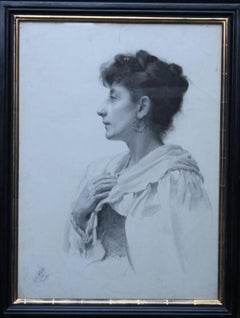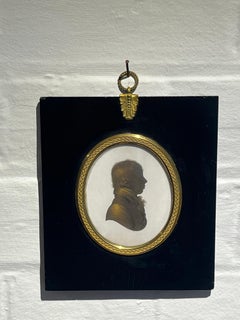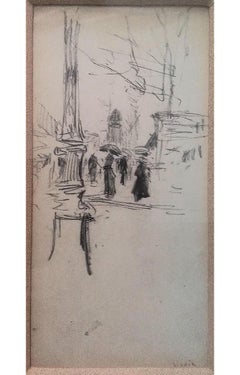Horace Henry Cauty Art
British, 1846-1906
Horace Henry Cauty, a painter of genre, portraits, landscape and historical subject matter, was born in Southwark, London and is the son of an artist. Cauty was a member of the RBA, serving as Secretary when James Abbott McNeill Whistler was President.
to
1
1
Overall Width
to
Overall Height
to
1
1
1
1
8,228
2,805
1,654
1,315
1
Artist: Horace Henry Cauty
Portrait of a Lady -British Victorian art female portrait realist pencil drawing
By Horace Henry Cauty
Located in London, GB
A fine large half-length portrait of a lady which was drawn in the late 19th century by British artist Horace Henry Cauty. A stunning and detailed work it is dated May 1892. It is a...
Category
Late 19th Century Victorian Horace Henry Cauty Art
Materials
Pencil
Related Items
John Field early 19th Century Georgian English silhouette portrait
Located in Harkstead, GB
A very finely detailed silhouette in very good condition by one of the truly great silhouette artists of the Georgian period.
John Field (1758-1821)
Portrait of a young gentleman
Watercolour with bronze touches on plaster
3 x 2½ inches, oval, without the frame
6 x 5 inches with the frame
John Field was one of the most famous of silhouette artists. He began his career as an assistant to John Miers...
Category
Early 19th Century Victorian Horace Henry Cauty Art
Materials
Bronze
$416 Sale Price
20% Off
H 3 in W 2.5 in D 0.5 in
Luigi Loir-Paris - Elegant On The Boulevard, pencil on paper- signed
By Luigi Loir
Located in PARIS, FR
Excellent overall conditions.
Free US CONTINENTAL Shipping, incl Europe and Asia.
Luigi Loir was born in Gorritz, Austria, to French parents. His father and mother were in the serv...
Category
Late 19th Century Impressionist Horace Henry Cauty Art
Materials
Pencil
$360
H 5.51 in W 3.14 in
Early 20th century English portrait of a young girl, Deborah Blencowe
By Louise Burrell
Located in Woodbury, CT
Louise H. "Louie" Burrell (née Luker 1873 – 1971) was an English-born artist who also lived in Canada and the United States.
The daughter of William and Ada Luker, both artists, Bur...
Category
1920s Victorian Horace Henry Cauty Art
Materials
Paper, Watercolor
$1,160 Sale Price
20% Off
H 4.14 in W 2.96 in
Pair of 19th century English chalk drawing on paper of Cockerel
By William Huggins
Located in Woodbury, CT
William Huggins was born in Liverpool, England on the 13th of May, 1820. His parents were Samuel and Elisabeth Huggins. He took his first drawing lessons from the Liverpool Mechanics...
Category
1870s Victorian Horace Henry Cauty Art
Materials
Paper, Pastel
$3,160 Sale Price
20% Off
H 9 in W 10 in
Old Testament Scene with Angel 1813 Large Grisaille Drawing on Paper Signed
Located in Stockholm, SE
One of the characters in this scene is a mature man, kneeling with his head bowed and hands clasped near his chest in a gesture of supplication. His posture conveys a sense of humili...
Category
Early 19th Century Realist Horace Henry Cauty Art
Materials
Mahogany, Paper, Watercolor, Pencil
Circle of Myles Birket Foster, Portrait of a red haired girl
By Myles Birket Foster
Located in Harkstead, GB
This exceptional quality watercolour depicts a snapshot of innocence and childhood with this delightful portrait of a red-haired young girl. Presented in a fine quality, hand carved and pierced, period frame with inlaid detail.
Circle of Myles Birket Foster (1825-1899)
Portrait of a red-haired young girl
Watercolour with touches of white
4 inches diamter (image only)
11 x 11 inches with frame
This beautiful image is of exceptional quality, as apparent in the delicate detailing to her eyelashes and the sunlit highlights of her hair. This is the work of an artist at the very peak of their powers and the intimacy of the work suggests a connection between artist and sitter such as daughter and parent. The level of draughtsmanship brings to mind artists from this period such as Myles Birket Foster, Fred Morgan and Helen...
Category
Late 19th Century Victorian Horace Henry Cauty Art
Materials
Watercolor, Paper
Victorian School head study of a golden haired boy
By George Elgar Hicks
Located in Harkstead, GB
A beautifully painted study of a cherubic young boy, his golden haired head turned to the sun, his eyes closed as he feels its warmth.
Pre-Raphaelite School, late 19th century
Head...
Category
Late 19th Century Victorian Horace Henry Cauty Art
Materials
Watercolor, Paper
Early 20th century English portrait of a red haired young girl
By Louise Burrell
Located in Woodbury, CT
Louise H. "Louie" Burrell (née Luker 1873 – 1971) was an English-born artist who also lived in Canada and the United States.
The daughter of William and Ada Luker, both artists, Bur...
Category
1920s Victorian Horace Henry Cauty Art
Materials
Paper, Watercolor
$1,750
H 7.29 in W 6.11 in
The Argument
Located in New York, NY
Signed and inscribed on a label on the verso:
No. 1/ The Argument/ W. Cave Thomas/ 203 Camden Rd/ NW
Provenance:
Christie’s, London, 6 November 1995, lot 88.
Private Collection, London.
This powerful watercolor is a mature work by the little-known Victorian painter William Cave Thomas...
Category
19th Century Pre-Raphaelite Horace Henry Cauty Art
Materials
Paper, Watercolor, Pencil
Portrait of a Young Woman
By Sir Peter Lely
Located in London, GB
Red chalk on paper
Image size: 7 1/2 x 9 1/4 inches (19 x 23.5 cm)
Contemporary frame
An enigmatic portrait of a young woman after Sir Peter Lely's drawing, currently shown in the B...
Category
Mid-17th Century Victorian Horace Henry Cauty Art
Materials
Paper, Chalk
Portrait of a Young Man, 19th Century English, Charcoal, Signed and Dated '1888'
Located in London, GB
Charcoal on paper, signed and dated '1888' bottom right
Image size: 9 x 7 1/2 inches (22.75 x 19 cm)
Period frame
The half-length portrait depicts the subject sat, wearing a white s...
Category
1880s Victorian Horace Henry Cauty Art
Materials
Paper, Charcoal
Eugène Devéria (1805-1865) The Children of the painter Drawing
By Eugene Deveria
Located in Paris, FR
Eugène Devéria (1805-1865)
The children of the painter
Portrait in an oval, study for a portrait
Black pencil on paper
23 x 19 cm
Stamp of the worksh...
Category
1840s Romantic Horace Henry Cauty Art
Materials
Pencil
$1,058
H 9.06 in W 7.49 in
Horace Henry Cauty art for sale on 1stDibs.
Find a wide variety of authentic Horace Henry Cauty art available for sale on 1stDibs. You can also browse by medium to find art by Horace Henry Cauty in pencil and more. Not every interior allows for large Horace Henry Cauty art, so small editions measuring 25 inches across are available. Customers who are interested in this artist might also find the work of John Fulleylove, George Goodwin Kilburne, and Henry Alken. Horace Henry Cauty art prices can differ depending upon medium, time period and other attributes. On 1stDibs, the price for these items starts at $4,662 and tops out at $4,662, while the average work can sell for $4,662.


